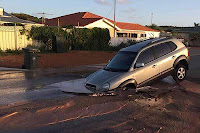A couple escaped without serious injury after their car was swallowed by a sinkhole at Glen Osmond in the Adelaide Hills of South Australia, at about 11.30 pm local time on Tuesday 4 October 2016. The pair were in the vehicle at an overlook when the hole opened up beneath them; they were able to escape unharmed, but the car could only be removed with the help of a crane.
Vehicle trapped in a sinkhole at 4 Glen Osmond on 4 October 2016. Denny Spence/ABC.
Sinkholes
are generally caused by water eroding soft limestone or unconsolidated
deposits from beneath, causing a hole that works its way upwards and
eventually opening spectacularly at the surface. Where there are
unconsolidated deposits at the surface they can infill from the sides,
apparently swallowing objects at the surface, including people, without
trace.
The Glen Osmond sinkhole is thought to have occured due to subsidence into an old mineshaft; the area was a center of mining from about 150 years ago up until about 40 years ago. The collapse is likely to have be related to heavy rainfall that has fallen across South Australia this summer, driven by a climatic event called a Negative Indian Ocean Dipole Phase.
Indian Ocean Dipole Phases are similar to the El Niño/La Niña
climatic oscillation that affect the Pacific Ocean. Under normal
circumstances equatorial waters off the east coast of Africa and west
coast of Indonesia are roughly similar in temperature, however during a
Negative Indian Ocean Dipole Phase the waters off the coast of Indonesia
become significantly warmer. As the prevailing currents in the area
flow west to east, this warm water is then pushed onto the shallower
continental shelf of north Australia, where it warms the air over the
sea more rapidly, leading to increased evaporation (which fuels rain)
and a drop in air pressure over the east Indian Ocean and west Pacific.
This in turn drives air currents over the Indian Ocean to flow more
strongly west to east, leading to higher rates of cooling off the coast
of Africa (where more water is drawn up from the cool sea depths) and
more warming off the coast of Indonesia, fuelling a feedback cycle that
tends to remain through the winter season in any year when it forms.
This leads to a particularly wet winter across much of Australia, as
well as a potentially damaging heatwave in the north, while much of East
Africa is at risk of drought (during a Positive Indian Ocean Dipole
Phase the reverse happens, with drought in Australia and flooding in
East Africa).
Areas of warming and cooling and air flow during a Negative Indian Ocean Dipole Phase. Australian Bureau of Meteorology.
See also...
 Evacuations begin amid widespread flooding in South Australia. The South Australian State Emergency Service
has begun evacuating people from low lying areas in Old Noarlunga and
other parts of the Onkaparinga River basin, as well as parts of the
Adelaide Hills and...
Evacuations begin amid widespread flooding in South Australia. The South Australian State Emergency Service
has begun evacuating people from low lying areas in Old Noarlunga and
other parts of the Onkaparinga River basin, as well as parts of the
Adelaide Hills and... Car trapped by sinkhole at Cape Burney, Western Australia. A car became trapped after falling into a sinkhole at Cape Burney near
Geraldtown in Western Australia at about 6,40 a.m. local time on Sunday
31 July 2016. The driver of the car, Ms Naomi Suckling...
Car trapped by sinkhole at Cape Burney, Western Australia. A car became trapped after falling into a sinkhole at Cape Burney near
Geraldtown in Western Australia at about 6,40 a.m. local time on Sunday
31 July 2016. The driver of the car, Ms Naomi Suckling...  Widespread flooding in southeast Australia. Widespread flooding and at least one fatality have been reported in New
South Wales, Victoria and South Australia following heavy rainfall
across the region on Sunday 3 and Monday 4 January 2016. Authorities are
advising against driving into floodwaters and...
Widespread flooding in southeast Australia. Widespread flooding and at least one fatality have been reported in New
South Wales, Victoria and South Australia following heavy rainfall
across the region on Sunday 3 and Monday 4 January 2016. Authorities are
advising against driving into floodwaters and...
Follow Sciency Thoughts on Facebook.


